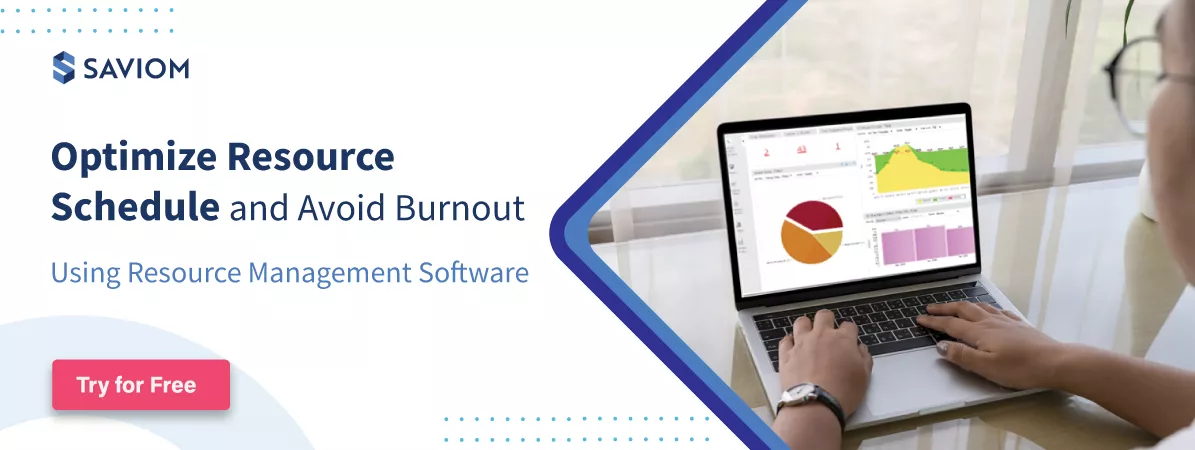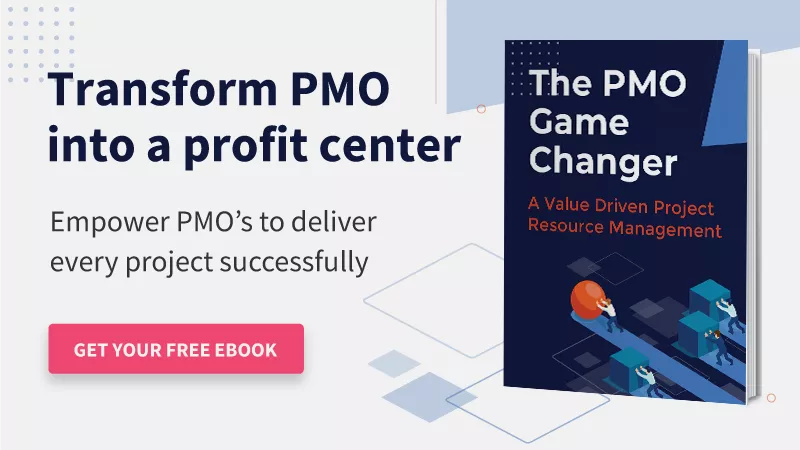The workforce is the most valuable asset for any organization. Their core competencies, hard work, and dedication help you succeed and make a mark in the industry. Managers must therefore implement the right resourcing measures to utilize their skills to the maximum while maintaining the resource health index.
However, a Forbes survey says that 61% of employees are burned out on the job.
To keep this percentage to a minimum, the onus is on managers and decision-makers to ensure that none of their employees are over-utilized, disengaged, or burned out at the workplace. However, often it happens when an ad hoc task comes up, and due to limited resource availability, you assign it to an employee who is booked for his/her total capacity. Overloading the resource will eventually lead to burn out and lowered productivity.
Project managers can combat this challenge with smart project planning and certain resource optimization techniques. Resource leveling is one such technique that helps you manage resource schedules efficiently. Implementing this technique will enable the decision-makers to accomplish critical project tasks in the stipulated time.
This blog emphasizes the basic concepts of resource leveling and its importance in the project management landscape.

Let’s begin by understanding the definition,
What is resource leveling?
According to the Project Management Body of Knowledge (PMBOK) Guide, resource leveling is defined as ‘A technique in which start and finish dates are adjusted based on resource constraints with the goal of balancing the demand for resources with the available supply’.
Consider an example for better understanding,
One of your project tasks is allocated to a resource who is working on two other projects in parallel. In this case, there is a chance that the resource is working beyond his/her capacity. To ensure that the employee is not over-utilized, you go ahead and adjust the project timeline in accord with the availability of that critical employee.
This process of extending the project deadlines or adjusting the project commence dates to align the resource demand against the available capacity is known as resource-leveling.
Read More: How to Measure Resource Capacity and Demand
Another technique often used to optimize resource allocation is resource smoothing. Here is a brief comparison of the two:
Resource leveling vs. Resource smoothing
As mentioned earlier, the main constraint in resource leveling is the availability of resources. On the contrary, the project deadline (the end date) is a limitation in resource smoothing.
Resource smoothing, also known as Time Constrained Scheduling, is a technique used to optimize the resource schedules without altering the project timeline. For instance, your resource is booked on a task for 8 hours for 10 days. However, the actual time required to accomplish the task is 60 hours. In this case, managers can go ahead and redistribute the schedule to 6 hours a day.
This practice eases the employee’s schedule and allows him/her to focus on other projects or tasks without hampering the deadline.
The key difference between leveling and smoothing is that managers can modify the timeline and critical path method in leveling unlike in resource smoothing. In addition to this, resource leveling is done when the workforce is overutilized while resource smoothing is performed in case of uneven resource allocation.
Real-life examples
Resource Leveling
An ideal scenario where resource-leveling works the best is a research project. It demands scientists with niche expertise to carry out the research and accomplish the project. However, these resources are not readily available to take up the job.
This is when Resource leveling comes into the picture where the project end dates are usually extended to assign the task to the right person without over-allocating them.
Resource Smoothing
As mentioned earlier, resource smoothing is deployed when projects have a time constraint. A prime example is a banking project. Usually, firms have a deadline when they are filing bank applications, or else they might face a loss. Thus, extending the project timeline is not the right choice here.
Instead, to deliver the project on time, project managers implement resource smoothing to even the resource allocations. They can also book an additional resource to finish the task faster and avoid over-scheduling one employee.
Read More: What is Resource Scheduling? How to Schedule Resources for Projects Efficiently?
Let us now understand how does resource leveling help in the project management realm:
Benefits of Resource Leveling in Project Management
The motive behind implementing resource leveling is to avoid over-utilization of the available resources and prevent employee burnout.
When your resources are over-worked, it gradually lowers down their productivity, and they focus on meeting the deadline instead of delivering quality.
Resource leveling ensures that your employees give undivided attention to the high-priority project by shifting or altering the end dates. Here are the major benefits you can reap by practicing this technique:
- It eliminates over-allocation of the resource pool due to limited availability
- Managers can enhance their workforce productivity and prevent burnout by adjusting the project deadline
- Project managers have the leeway to use the appropriately skilled benched resources to complete a high-priority project on time.
- Leveling allows you to ensure the quality of the final output by enabling your resource to only focus on one task at hand.
- Resource managers can balance the resource demand with the existing capacity and maintain the overall resource health index.
In a nutshell, resource leveling helps you optimize resource schedules and set realistic project deadlines based on capacity, thereby ensuring the quality of the project.
Read More: Project Resource Management: An Ultimate Guide on How to Master it
Now that the basic concepts and significance is understood, let’s address some critical questions,
When do you require resource leveling?
Resource leveling is required when your resource demand exceeds the existing capacity or when a critical resource is not available on the given dates to take up the task. In other words, you need to level and manage the resource time when there is a shortage of resources to carry out the project work.
Going into details, resource leveling should be done when you are formulating the critical path of the project. In that case, if you don’t have enough hands on deck to execute the tasks, you can convey and negotiate a new deadline with the stakeholders or clients. This will help you set feasible deadlines and keep your clients informed at the right time.
There are 3 major techniques you can use to level the resource schedules. Here is a detailed description of each one of them:
The Resource leveling techniques
Critical Path Analysis
Documenting a Critical Path forms the foundation of successful project execution planning. It includes forming a sequential flow of project tasks and stating their interdependencies on each other using a pictorial flowchart. After every task is described, project managers analyze and assess the time required to complete each of them. This is done without considering the resource availability.
The next step is to evaluate the resources required and assess the existing demand and capacity gap. Once project managers are aware of the resource constraints, they will now go back and re-evaluate the start and finish dates of the project tasks.
In case the project timeline is not a constraint, the timelines will be altered subject to the resource schedules. However, if the project deadline cannot be altered, managers will pull-in more resources to perform the task and ensure timely execution. Decision-makers can make use of the shared services model and request inter-departmental or benched resources.
Read More: Maximize Profitable Resource Utilization with Modern Resource Management Solution
Fast-tracking
It’s impractical to expect every client to be flexible with the schedule (project timeline). Some projects have to be delivered on time or even before that (even during resource scarcity) to ascertain client satisfaction. In this case, project managers can start executing multiple tasks simultaneously instead of delivering them consecutively.
Note that, only the tasks that are independent of each other can be worked on in parallel.
To implement fast-tracking, managers first analyze the tasks in the critical path and understand which ones can be fully or partially accomplished without following the sequence.
When a project requires urgent delivery, certain sequential tasks can be executed simultaneously up to a certain limit. According to PMStudyCircle, managers can fast-track the activities by 33%, i.e. they can start the next task when the previous one is 66% done. That means they can partially overlap without compromising the quality of each.
In fast-tracking, managers are not over-allocating one resource to perform the tasks before the deadlines, but are asking the scheduled resources to work in parallel.
Read More: What is Resource Allocation? A Comprehensive Guide for Project Success
Crashing
There are multiple factors to be considered when deploying a certain technique for project delivery. When you fast-track the project tasks, it does not always work as expected. Not all the tasks in the critical path can be executed parallelly. Moreover, there may be two sequential tasks to be executed by the same resource. Thus, when fast-tracking is inconsequential, managers can implement the ‘crashing’ technique.
So, what is crashing?
If your client asks you to compress the project schedule, you can add more resources to accomplish the project tasks. Of course, not every task requires additional resources as it will substantially escalate the project costs. The decision-makers must diligently assess the tasks in the critical path first and add resources to the ones that are of high-priority and have multiple interdependencies.
At the same time, the cost of the additional workforce must be taken into consideration to avoid budget overruns. Furthermore, try and add resources to the tasks that will deliver the most business value. The earned value will balance the additional incurred project costs.
These are the three major resource leveling techniques used by the decision-makers to avoid over-allocation of resources.
Implementing a resource management solution will make resource leveling a breeze as it provides a 360-degree view of enterprise-wide resources.
In addition, it provides powerful real-time insights into resource schedule and availability and eliminates discrepancies.
Read More: Top Ten Business Benefits of Resource Management
The next section highlights the consequences of poor resource-leveling.
What happens due to poor resource leveling?
Resource leveling is ultimately a technique to balance the resource schedules and a solution to an emerging problem. So, the question is, what will happen when this goes wrong?
Here is a list of consequences:
- Escalated project costs due to extended project end dates and in case of crashing, the addition of new resources.
- Delays in project submissions can eventually cost you your client and business.
- Decreased employee productivity due to shuffled schedules and no value in return.
- The wrongful execution of critical project tasks will have a cascading effect on the entire project eventually bringing it to a standstill.
- Mobilizing and altering schedules for one project (that failed) will compromise and affect the projects that were parked due to this.
Read More: The Effects of Low Productivity on Business Growth
All these put together will eventually affect the bottom line and can even lower your reputation due to client dissatisfaction. Resource leveling must therefore be implemented systematically and every process and task must be documented to avoid any last-minute errors.
Read these summed-up tips (dos and don’ts) to ensure you level the resource schedules the right way.
Conclusion- Dos & Don’ts
Dos
- Equip an advanced resource management tool to gain enterprise-wide visibility of employees’ schedules.
- Prepare a work breakdown structure to state the interdependencies and resource demand while planning the project.
- Implement a resource leveling technique when drawing out a critical path to convey the shift in deadlines in time.
- Assess project priority before putting other projects on hold.
- Before going ahead and applying the fast-tracking technique, evaluate if crashing will be a better choice based on the sequential tasks.
- Use information from the past i.e. previous similar projects to draw out an accurate plan.
Don’ts
- Don’t use silos of spreadsheets to schedule and allocate resources. It will lead to double-booking eventually causing over-utilization.
- Avoid implementing leveling techniques on tasks that are out of the critical path. Because adjusting their timeline or adding more resources to them will only give them float. (Free float is the amount of time that a task can be delayed without impacting the subsequent task)
- Refrain from adding high-cost resources while deploying the crashing technique. It will escalate the project costs and reduce billability. Prefer deploying cost-effective global resources.
Ready to implement resource leveling in your organization yet?
The SAVIOM Solution
SAVIOM is the market leader in providing an Enterprise Resource Capacity Planning solution. With over 20 years of experience leading the market, Saviom is actively used by over 15 highly-esteemed global companies worldwide. The tools within the suite include project portfolio management, professional service automation, and workforce planning software. Re-engineer operational efficiency with a system shaped around your business!











